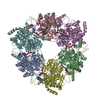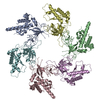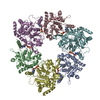+Search query
-Structure paper
| Title | Activity, substrate preference and structure of the HsMCM8/9 helicase. |
|---|---|
| Journal, issue, pages | Nucleic Acids Res, Vol. 51, Issue 14, Page 7330-7341, Year 2023 |
| Publish date | Aug 11, 2023 |
 Authors Authors | David R McKinzey / Chuxuan Li / Yang Gao / Michael A Trakselis /  |
| PubMed Abstract | The minichromosomal maintenance proteins, MCM8 and MCM9, are more recent evolutionary additions to the MCM family, only cooccurring in selected higher eukaryotes. Mutations in these genes are ...The minichromosomal maintenance proteins, MCM8 and MCM9, are more recent evolutionary additions to the MCM family, only cooccurring in selected higher eukaryotes. Mutations in these genes are directly linked to ovarian insufficiency, infertility, and several cancers. MCM8/9 appears to have ancillary roles in fork progression and recombination of broken replication forks. However, the biochemical activity, specificities and structures have not been adequately illustrated, making mechanistic determination difficult. Here, we show that human MCM8/9 (HsMCM8/9) is an ATP dependent DNA helicase that unwinds fork DNA substrates with a 3'-5' polarity. High affinity ssDNA binding occurs in the presence of nucleoside triphosphates, while ATP hydrolysis weakens the interaction with DNA. The cryo-EM structure of the HsMCM8/9 heterohexamer was solved at 4.3 Å revealing a trimer of heterodimer configuration with two types of interfacial AAA+ nucleotide binding sites that become more organized upon binding ADP. Local refinements of the N or C-terminal domains (NTD or CTD) improved the resolution to 3.9 or 4.1 Å, respectively, and shows a large displacement in the CTD. Changes in AAA+ CTD upon nucleotide binding and a large swing between the NTD and CTD likely implies that MCM8/9 utilizes a sequential subunit translocation mechanism for DNA unwinding. |
 External links External links |  Nucleic Acids Res / Nucleic Acids Res /  PubMed:37309874 / PubMed:37309874 /  PubMed Central PubMed Central |
| Methods | EM (single particle) |
| Resolution | 3.94 - 6.5 Å |
| Structure data | EMDB-40234, PDB-8s91: EMDB-40235, PDB-8s92: EMDB-40236, PDB-8s94:  EMDB-40237: Structure of wild-type MCM8/9 heterohexamer complex with ATP-gamma-S |
| Chemicals |  ChemComp-ADP:  ChemComp-MG: |
| Source |
|
 Keywords Keywords |  DNA BINDING PROTEIN / Helicase DNA Replication DNA repair / DNA BINDING PROTEIN / Helicase DNA Replication DNA repair /  DNA Replication / DNA Replication /  DNA repair DNA repair |
 Movie
Movie Controller
Controller Structure viewers
Structure viewers About Yorodumi Papers
About Yorodumi Papers










